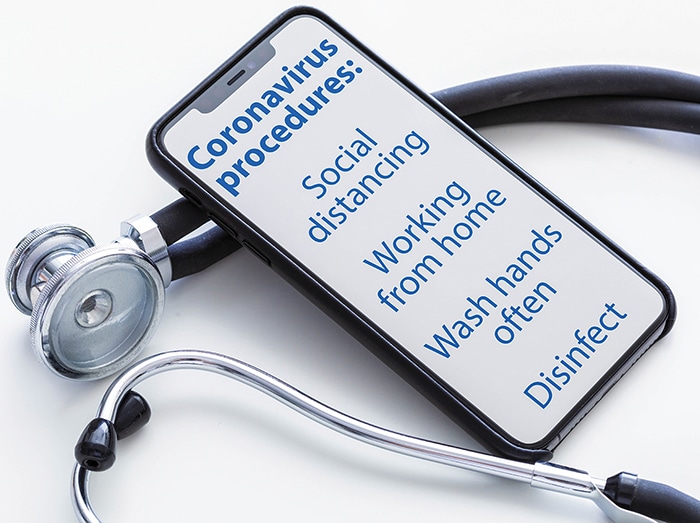
Almost two months ago, I penned a column urging folks to drive the COVID-19 speed limit.
I think this is just as true today as it was then, but the problem is I believe there is a growing number of people who want to step on the gas.
“Reaction to the COVID-19 virus by the public can be viewed in many ways similar to how people drive. There is a segment of the population that blasts along the highways, oblivious to road conditions; then there are the vast majority of drivers who take things a bit slower and adjust accordingly; followed by the group of drivers who overreact and crawl along at a snail’s pace,” I wrote in March.
The slow movers are the ones who take every precaution the government advises, and then some. They’re the ones who now have a two-year supply of toilet paper taking up space in a closet for no frigging reason other than buyer’s panic.
And then there are the folks who are protesting COVID restrictions; the people who brought their weapons into the Michigan Legislature, or the groups in B.C. who protested recently, saying it’s a health-care hoax, or who flocked to the beaches in close proximity to one another on the weekend. These are the speedsters who want to continue on with their lives as if nothing has happened – or more importantly, could happen. These are the speed junkies.
And then there are the rest of us, those who are driving not just the speed limit, but are adjusting their speed for the COVID-19 road conditions.
Yes, we “drove” in a safe manner early on. We washed our hands every time we came indoors, for 20 seconds, and squirted on hand sanitizer where it was provided (good luck buying any as the fear mongers hoarded that, along with the toilet paper).
We have gone into grocery stores, respecting social distancing, armed with a list of needed items, got them, and got out in an efficient manner. No browsing.
We have stayed away from friends and non-immediate family, further respecting social distancing guidelines.
And we helped flatten the curve. Heck, that curve has pretty much gone horizontal in Chatham-Kent. As I type this, we have eight active cases. We’ve had 94 overall.
Fortunately, only one person has perished in C-K due to COVID-19. A handful have been hospitalized, and we’ve managed to keep it out of long-term care homes, a killing ground for this virus in other municipalities, due to close quarters and weakened immune systems.
Chatham-Kent residents, municipal officials and our everyday heroes – essential workers – should take a bow. We’ve done what was asked, and then some.
But the next question begs: When can we get back to normal? Or even a new normal?
Seeing the province extend the five-person gathering limit through to the beginning of June is frustrating in a municipality with a much lower population density than where the urban federal and provincial decision makers live.
Fewer people, flatter COVID curve and a lower likelihood of contracting the virus.
Are we being too cautious? And as a result, are we pushing some of the people who have driven the COVID-19 speed limit for the past two months, to press on the gas?
I asked friends about their thoughts on our COVID-related restrictions, and received some very intelligent responses.
“I’d like to think we can use caution and discretion in what we do and begin to get things done. It’s hard not to go visit my dad, but he is in his 80s, so right now it’s not happening,” Greg commented.
Alysson said, “We are in Day 58 of physical isolation and I have not been closer than six feet to anyone besides my husband. This includes my parents and my 99-year-old great aunt, who I normally see several times a week. It’s really, really hard. But it keeps us all safe and worth the sacrifice.”
Thomas, who has had a heart transplant, is immunosuppressed.
“I’m going with the ‘scientific answer,’ not some ‘social media expert.’ I haven’t heard any discussion about ‘opening borders’ safely. We can flatten the curve all we want but what if the borders are opened too quickly in the name of reopening the economy faster?”
He’s bang on. Open our borders to the U.S. again, and I pity the folks in the border cities.
For people who think we should open things up more quickly – and I admit there are moments when I start pondering in that manner – look what has happened in other countries when they moved too fast to return to normal. For example, in South Korea, the reopening of nightclubs led to a spike in cases. China has seen a resurgence of the virus as it eased restrictions.
Large gatherings are still not smart moves. We may have six active cases, but who knows how many people are asymptomatic, walking around with the virus, but showing no signs of illness? Put one of those people innocently in a tight group of people, and suddenly you’re tracking numerous contact chains trying to see who might now be infected.
I am frustrated with the fact governments are still trying to legislate stupidity – putting rules, regulations, restrictions and laws into place to curtail the actions of the few idiots sprinkled amongst the rational masses.
Look at the five-person gathering rule. It does not mention the size of a yard, or if people are being intelligent about gathering. Put six people in to a big backyard, and it’s a violation, the same as 25 people crammed into a house for a party. But the likelihood of exposure in each case is vastly different.
What other choice do government officials have? If we can save lives, shouldn’t we make that effort? Or do you have no respect for society’s most vulnerable?
But are there ways we can loosen our restrictions a bit? In Taiwan, fans are allowed back into baseball stadiums, albeit in small numbers. No more than 1,000 spectators can attend games. They sit several seats apart and every second row is empty. Everyone’s temperature is checked at the entrance as well.
With such restrictions in mind, could C-K restaurants reopen with perhaps a third of the tables in use? What about potential contamination in, say the washrooms? What about PPE (personal protective equipment) for wait staff, food prep folks and dishwashers?
Many questions. Does anyone have the right answers as of yet?
I would consider taking my family to a restaurant (especially an outdoor patio) if proper spacing between tables was in place and I felt there were other precautions in effect. But you can’t eat with a mask on either.
How about seating in every second row of a theatre, but only in every third or fourth seat? I guess it would depend on sanitization practises from the theatre.
Side note: Drive-in theatres should be rocking this year, even if they play old movies.
How about beaches? No clustering in groups larger than five, but who sets the distance between each group? Is that safe?
So many questions. There is no simple solution; guidelines need to be fluid. If the COVID-positive numbers increase – and they will as people begin to interact again – then tighter restrictions might again be necessary.
And that is frustrating. Because no one truly feels in control of their own lives.






